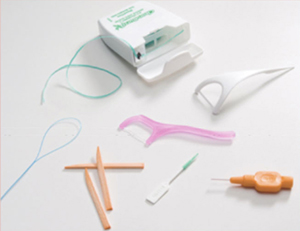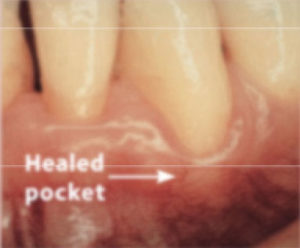
PERIODIC PERIODONTAL CLEANINGS HELP YOU STAY ON TOP OF GUM DISEASE
If you have periodontal (perry-o-DON-tal) disease (also called gum disease), you may already have had a special deep cleaning called scaling and root planing. You also may have had periodontal surgery. The periodic cleanings recommended after these treatments are called periodontal maintenance therapy.
The purpose of these cleanings is to help you keep your gums healthy and make sure that periodontal disease does not get worse.
Periodontal probe of healthy gums
Periodontal probe showing a pocket forming between the tooth root and the gums
YOUR PERIODONTAL DISEASE WON’T GO AWAY ON ITS OWN
Once your periodontal disease is brought under control, it is very important that you get dental care on a regular basis. Cleaning your mouth every day at home is critical, but it’s not enough on its own to keep your gum disease under control. Professional dental care is needed to help control gum disease.
Periodontal maintenance involves a cleaning that goes deeper below the gumline than a regular dental cleaning. You need deeper cleanings because spaces have formed between your teeth and gums. These spaces are called periodontal pockets. Bacteria collects in these pockets and eventually the bone that supports the teeth may be destroyed. The deeper the pocket, the worse your gum disease may be. Periodontal maintenance helps to keep pockets from getting deeper, allowing your gums to heal.
If the bacteria continue to grow, your gums can become red, puffy, swollen and no longer tightly hug your teeth. This can also create bone loss, which causes your teeth to become loose.
With periodic maintenance, the amount of plaque bacteria is lowered. Then, the inflammation can get better, pockets can shrink and your gums can become healthier.
Once gums are healthy, periodic cleanings can help keep them free from infection. Your dentist may also recommend and use medicines to help lower the periodontal bacteria in your mouth. The medicine could be a pill, a special mouthrinse or a medication that your dentist places right into the pocket after you have a deep cleaning.
PLAN FOR MORE VISITS TO YOUR DENTIST
You will need to see your dentist more often than other people. The pockets and other issues from your gum disease will make it harder for you to clean plaque from your teeth on your own. Your dentist will recommend a treatment schedule that is based on your diagnosis. Be sure to keep all dental appointments.
Your dentist may also refer you to a periodontist (perry-o-DON-tist) — a dentist who specializes in the treatment of gum disease. A periodontist is well versed in the surgical treatment of gum disease. Your visits may switch between your dentist and your periodontist.
Periodontal maintenance appointments are more frequent than regular cleanings, sometimes as often as every 3 to 4 months, depending on your condition. Over time, fewer appointments may be necessary. Even if you don’t feel any pain, your gum disease may not have healed completely, so it’s important to keep all your appointments and continue with at-home care. If you follow through with your maintenance, you are more likely to keep your teeth. If not, your gum disease may get worse.
Before Treatment
After treatment
YOUR TEETH AND GUMS MAY BE SENSITIVE
Your teeth and gums may be sensitive after your treatment. This soreness may make
you want to avoid cleaning the treated areas. But it’s important to follow your dentist’s instructions on home care! If plaque is not removed, root decay may form. Talk with your dentist or hygienist to see if a special toothpaste or other treatments can lower your tooth sensitivity.
KEEP BRUSHING AND CLEANING BETWEEN YOUR TEETH!
Brushing and cleaning between your teeth daily are important for everyone, but even more so if you have gum disease. You should brush your teeth two times each day with a toothpaste that contains fluoride.

Your dentist or hygienist may recommend that you use a mouthrinse or powered toothbrush. Look for the American Dental Association Seal of Acceptance on all dental care products. The ADA Seal tells you that the product meets ADA standards for safety and effectiveness.
Use floss or another between-the-teeth cleaner every day to remove the plaque and bits of food between your teeth and gums.
YOUR ORAL HEALTH AFFECTS YOUR OVERALL HEALTH
- Gum disease is common in people with diabetes, obesity and some forms of heart disease.
- Do not use tobacco in any form. Smoking, chewing and dipping puts you at a higher risk for cancer and other life-threatening diseases. Tobacco use also can make gum disease worse and make it harder to treat. If you use tobacco, ask your dentist or physician for information about how to quit.
DO YOUR PART AND WORK WITH YOUR DENTAL TEAM
With the help of your dental team, you don’t have to lose your teeth to gum disease. Periodontal maintenance is most effective if you and your dental team work together.
Your dentist has treated your gum disease, but you must also do your part and take good care of your teeth and gums at home every day.
IS TREATMENT COVERED BY MY DENTAL BENEFITS PLAN?
Check with your dental plan when you are planning treatment with your dental office.
However, you should make treatment decisions based on what’s best for your health, not just what is covered by your plan.
If your treatment is not fully covered by insurance, ask the dental office if it has a payment plan to cover the rest. Keep in mind that having periodontal treatment now may be less expensive than replacing a tooth lost to disease!




